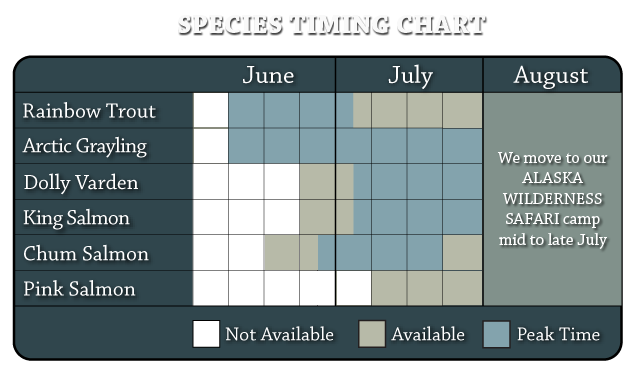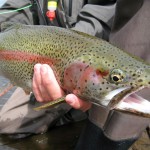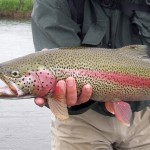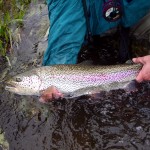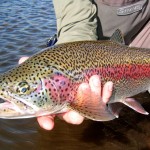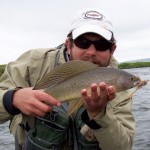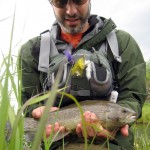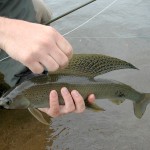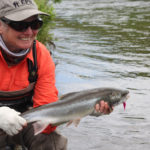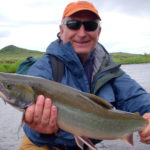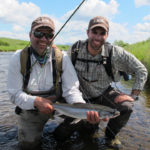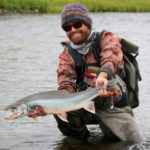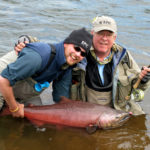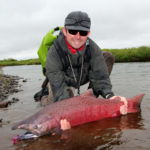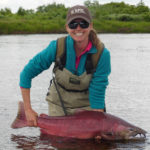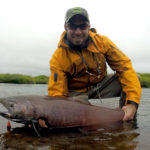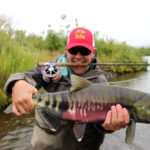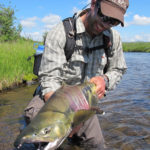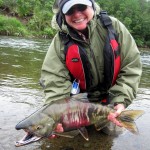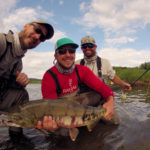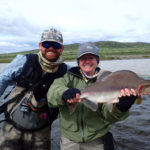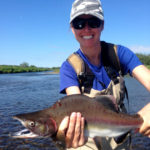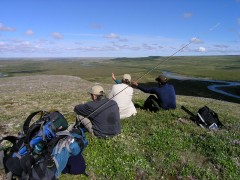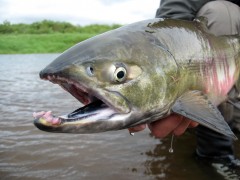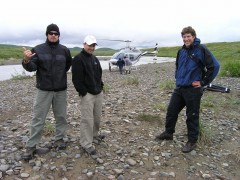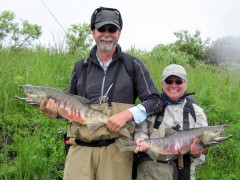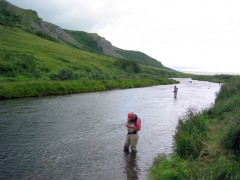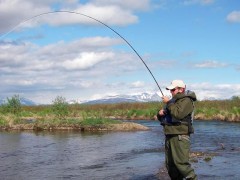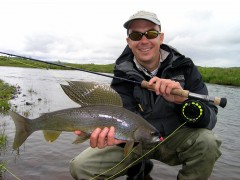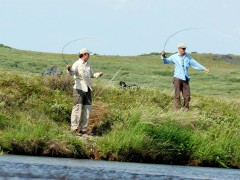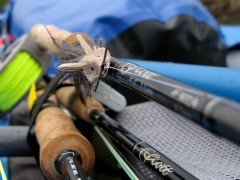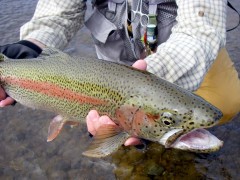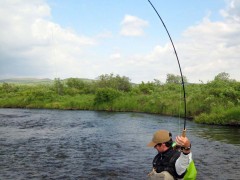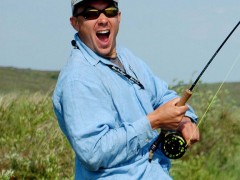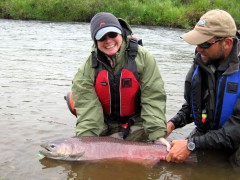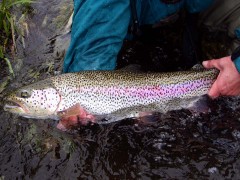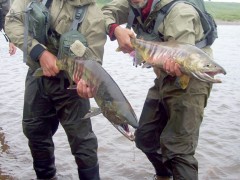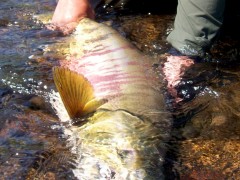The Fish
Rainbow Trout
aka "Trout"
Few fish species are passionately pursued by so many, and the wild Alaskan rainbow trout represents so much. They are hungry, explosive, moody, challenging, elusive and beautiful. Relative to the size and remoteness of our watershed, this experience may very well challenge some of the best rainbow trout waters in Alaska – and it just doesn’t get any better than watching these trout slam top water mice patterns!
The rainbow trout in this watershed range from 10 – 26 inches, with the median fish between 16 to 18 inches and some trout in the 20 – 24 inch range (26+ inches possible but rare). Fish are consistently taken on top-water mice patterns and streamers throughout the season. Large dry flies and nymph action is fairly reliable prior to the salmon runs. Eggs imitations, of course, are productive as well.
Don’t let the lure of a “30 incher” prevent you from experiencing our truly remote Alaska trout fishing, where you probably won’t see any other anglers your entire week. And by the way, yes, 30 inch trout do exist in Alaska, but they certainly aren’t as common as most places want you to believe!
Click this link, rainbow trout, for more information.
Rod
7 weight rod with medium-fast to fast actionReel
Durable reels with medium to strong disc drag and 150 yards of 20 pound backingLine
A floating line works well in most all conditionsLeader
8 - 12 pound
Arctic Grayling
aka "Sailfish of the North"
If you want to catch wild Alaskan fish on dry flies literally all day long, the grayling are impossible to beat. These voracious eaters are also opportunistic and aggressive on nymphs, streamers, egg patterns and this is the only place in Alaska we have consistently taken grayling on mice patterns. Yes, they are that hungry! And, yes, sometimes they can’t get their mouth around the big mouse patterns we love to throw.
In this watershed the grayling range from 10 – 18+ inches, average about 14 inches, and are sure to put a smile on your face with light tackle.
Click this link, arctic grayling, for more information.
Rod
5 weight rod with medium to medium-fast actionReel
Quality reel to match rodLine
A floating line is all you needLeader
6 to 8 pound
Dolly Varden
aka "Char or Arctic Char"
Once the salmon show up in good numbers, big numbers of dollies follow them up river and stage just downstream of the spawning behemoths, who can individually drop thousands of eggs in the stream.
The dollies are voracious, hard hitting and feed aggressively on salmon egg imitations and streamers, some days mice patterns. Once hooked, often during egg-induced feeding frenzies, the dollies are surprisingly tenacious fighters – they just don’t ever seem to give up – and can definitely put a good bend in a fly rod and a BIG smile on your face.
Fish of this type typically range from 12 – 24 inches and average 18 to 20 inches. However, some seasons bringer larger fish in the 18 – 26+ inch range.
The camp record, landed in 2015, is 30.25 inches.
Click this link, Dolly Varden, for more information.
Rod
6 to 7 weight rods with medium to fast actionReel
Quality reel with disc drag to match rodLine
A floating line works well in all conditionsLeader
8 to 10 pound
King Salmon
aka "Chinook"
Want to battle behemoth sized fish? Try sight casting to these “giant red missiles” in a small stream and you’ll experience Alaska’s biggest and strongest salmon species. And these battle-ready fish will definitely put your 9 weight rod to the test!
The king salmon in this watershed range from 6 pounds to the possible but rare 25+ pounds, with most fish ranging 8 to 20 pounds. Big bright streamers placed right on the end of their nose usually does the trick. Yes, they can be finicky! Heavily weighted flies and persistence are paramount. Sink-tip fly lines can be helpful if the flows are higher than normal, but a floating lines does the trick 99% of the time.
If fly fishing for king salmon is a trip priority for you, target July 4th or later.
Rod
9 or 10 weight single handed rods with medium-fast to fast actionReel
Durable reels with strong disc drag and 200 yards of 30 pound backingLine
A floating line works well in most conditions. Helpful at times: a sink tip in the 10 to 15 foot range with a medium to fast sink rate.Leader
20 pound
Chum Salmon
aka "Tiger, Calico or Dog Salmon"
We see strong numbers of chum salmon (a.k.a. “tiger salmon“) in this watershed and they consistently take a fly. These hard fighting fish have been overlooked by fly anglers for many years and now have a reputation for knuckle-pounding battles… and we’ve seen reels nearly spooled when these guys find heavy current. (We actually recovered an entire fly line, 4 hours later and a mile upstream, still attached to the chum salmon that broke it off!)
Also know as a “tiger salmon” for their eye-catching and unique red striping, catching these fish are sure to put a BIG smile on your face (and a burn in your bicep)!
Fish range from 6 – 14 pounds, average 8 – 9 pounds.
Click this link, chum salmon, for more information.
Rod
7 to 8 weight rods with medium-fast to fast actionReel
Durable reels with medium to strong disc drag and 150 yards of 30 pound backingLine
A floating line works well in most conditions.Leader
15 pound
Pink Salmon
aka "Humpy"
Generically speaking, in Bristol Bay pink salmon noticeably run strongest in even years (2014, 2016, etc.). In our home drainage the pink run appears to be somewhat variable, but they show up in reasonable numbers most even years – enough for you to catch them in mid to late July. Fish range from 2 to 6 pounds and put a good bend in a 6 weight fly rod.
Rod
6 to 7 weight rods with medium-fast to fast actionReel
Durable reels with medium to strong disc drag and 150 yards of 20 pound backingLine
A floating line works well in most conditionsLeader
12 to 15 pound

